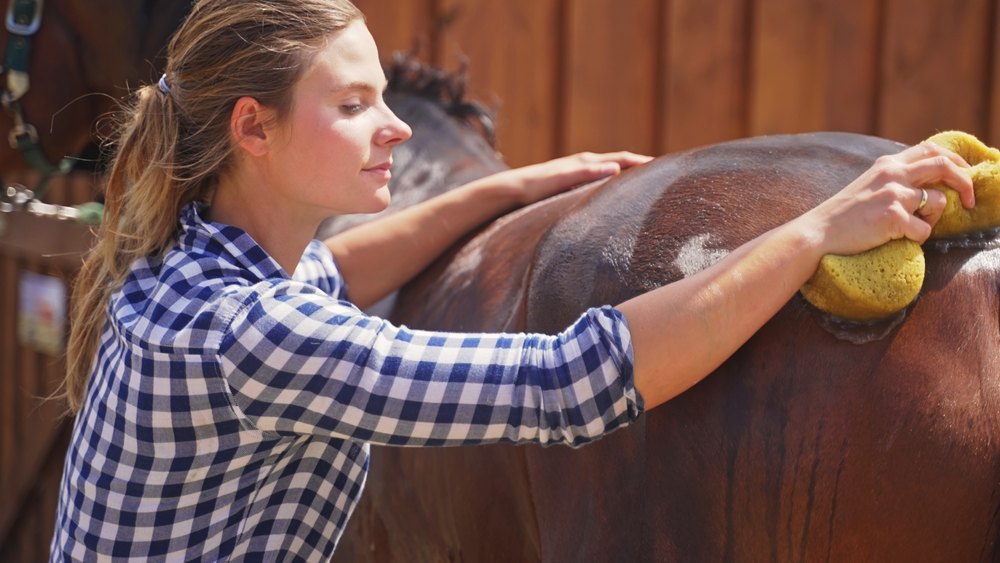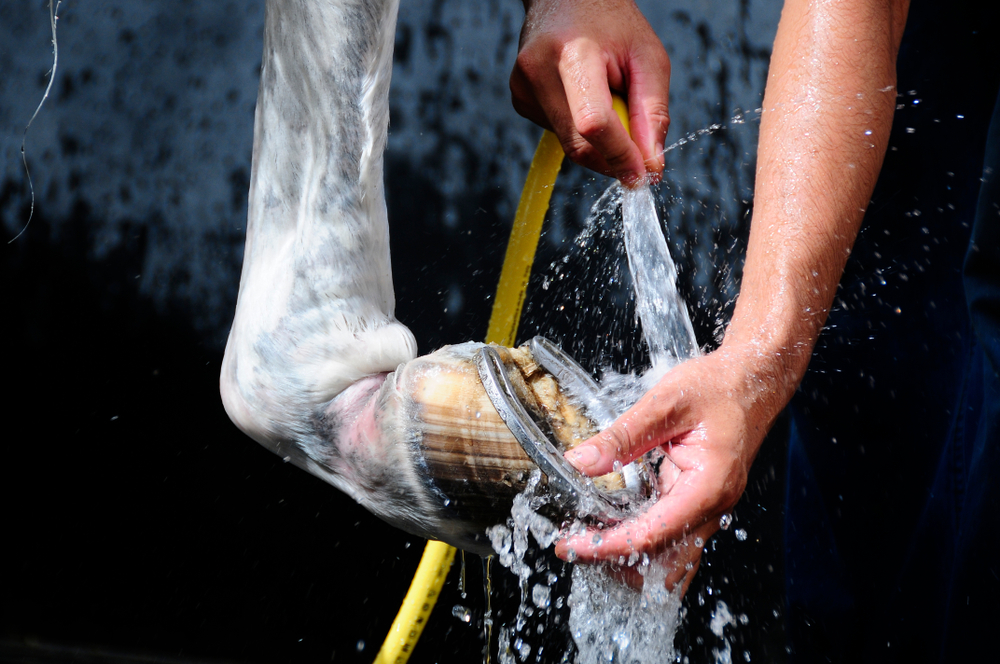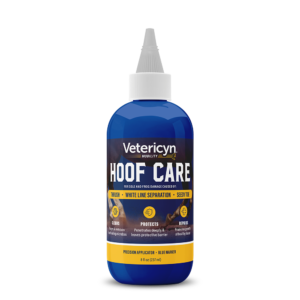Updated 6/25/2025
There’s fungus among us—144,000 different types, to be more or less exact.1 They’re in your bread, your wine, your creamy mushroom pasta… but hopefully not your horse.
A fungal infection in horses can crop up in a couple of different places, from the skin to the hooves. As such, treatment plans look different depending on where the fungus has decided to fester. But most often, fungal infections in horses can be treated easily with an antifungal medication or treatment.
Read on to learn about these fungal infections and what to do if your horse starts showing symptoms.
Causes of Fungal Infections in Horses
Although there’s an incredible amount of fungi in the environment, only a few can actually cause infections. These can infect the horse in a handful of different ways.
The most severe infections, the kind that threaten internal organs, are typically inhaled or ingested through drinking water.2 Fortunately, these severe infections are pretty rare.2
Hoof fungal infections may occur due to contamination from the environment, especially in humid weather or poorly maintained lodging, poor foot care, and direct exposure to affected animals or contaminated grooming supplies.2,3 Horses suffering from other diseases may be more susceptible to getting fungal hoof infections.3
Types of Fungal Infections in Horses
Fungi are microorganisms, and they sometimes cause infections known as mycoses. Mycoses that can cause fungal infections in horses usually fall into one of the following categories3:
- Superficial mycoses – Mild, typically mild infections usually caused by an existing health issue.
- Cutaneous infections – Infections of the skin, hair, hooves, and other tissue. These are common and usually surface-level.
- Subcutaneous infections – These infections affect similar parts of the body as cutaneous infections but are more serious and harder to treat.
- Deep mycoses – The most threatening infections. They typically affect the respiratory system and sometimes travel through the bloodstream.
The most common equine fungal foes are visible on the surface of the skin and hooves. You’re probably familiar with ringworm infection, which despite the name, is actually a cutaneous fungal infection.2 You can recognize it by the scabby, hairless patches of skin around your horse’s head, neck, and shoulders. This is contagious to other animals and people.3
White line disease happens when bacteria or yeast infect a gap or separation in a horse’s hoof. It affects horses of any age and breed, occurs on shod or barefoot horses, may affect multiple horses on one farm, and is found worldwide. Many causes have been proposed but none have been proven. Mechanical stress on the hoof wall, such as from excessive toe length, poor hoof shape, or distortions like long toe–underrun heel, clubfoot, or sheared heels, can cause the hoof wall to separate.5

Treating Fungal Infections in Horses
Treatment for a fungal infection depends on what kind of infection your horse is experiencing. Severe cases with large lesions or growths might require surgery.3 Antifungal medication is often prescribed, either as an injection, oral medication, or a topical treatment.3
Treating Skin Fungal Infections
If you want to know how to treat horse ringworm, girth itch, yeast, or any other fungal skin disease, start by isolating the horse from other animals in case it’s contagious and use a medicated antifungal shampoo.4 Vetericyn’s FoamCare medicated shampoo is an antifungal shampoo. Wear gloves when handling horses with fungal infections. Spray the shampoo evenly over the horse’s coat and lather to get down deep to the skin. Be sure to completely rinse the soap off before drying. Sunlight and fresh air help to kill the fungus.4 Call your veterinarian if the lesions worsen or don’t improve.
Clean all tack and grooming tools with a fungicide to ensure the infection doesn’t come back or spread to other horses.Quarantine horses new to the farm for two weeks, and keep separate tack and grooming equipment for each horse.4
Take extra precautions as many of these infections, like ringworm, are zoonotic, meaning they can transfer to you, your family members, or other pets.4 Take preventative measures while treating your horse by wearing gloves and long sleeves and washing your hands thoroughly. If you are immunocompromised, have someone else treat the infected horse.6

Treating Hoof Fungal Infections
Infections of the hoof are best treated with a thorough visual exam, debridement and smoothing of affected tissue, and antifungal application.7 and Coat the hooves in a treatment like Vetericyn Hoof Care to purge the fungus and apply it regularly as directed by your veterinarian.
For infections that have crept deeper into the hoof, you will need a more robust treatment. Powerful chemical solutions like Vetericyn Hoof Soak can penetrate into the infected hoof cavity and begin the healing process. After debridement and smoothing of the affected area, mix the medical powder with water and let the hoof soak for 40 to 60 minutes. You should be able to see the infected material purging from the hoof.
If you need help diagnosing a hoof problem, or if your horse is showing signs of lameness, seek help from an equine veterinarian.
Preventing Fungal Infections in Horses
There are steps you can take to help prevent these troublesome fungal infections, including:.
-
- Don’t share tack or grooming tools between horses4
- Treat wounds with an antifungal spray like Vetericyn Plus
- Quarantine new horses brought to your stables4
- Practice good hoof hygiene2
- Keep living environments clean and dry2
Fight Horse Fungal Infections with Vetericyn
Fungal infections in our horses are never welcome. Kick them to the curb with Vetericyn.
Our medicated equine shampoo is a gentle and effective antifungal formula designed to stop fungi in their tracks. Then, use Vetericyn Plus to stop infections from spreading.
Treat your horse to the high-quality health it needs and deserves. Trust the experts at Vetericyn to deliver equine care products that help you achieve it.
 Reviewed by Dr. Kathy Adamson
Reviewed by Dr. Kathy Adamson
Dr. Kathy Adamson earned her bachelor’s degree from the University of Notre Dame and her Doctor of Veterinary Medicine degree from the University of Wisconsin-Madison School of Veterinary Medicine.
She completed a one-year small animal medicine and surgery internship at the North Carolina State College of Veterinary Medicine. Alongside her studies, Kathy worked in a research lab, contributing as an author and co-author to various journal articles.
She has also pursued medical writing and editing certification through the University of Chicago Graham School. Currently, she runs KMA Veterinary & Medical Writing, a freelance medical writing company, serves as the Digital Content Manager for the Greater Chicago Area Chapter of the American Medical Writers Association, is a member of the AMWA Communications Committee, and enjoys writing about healthcare topics for people and their cherished pets.
![]() https://www.linkedin.com/in/kathyadamsondvm/
https://www.linkedin.com/in/kathyadamsondvm/
Sources:
- Encyclopaedia Britannica. Fungus. https://www.britannica.com/science/fungus
- The Horse. Demystifying Fungal Infections of the Equine Hoof. https://thehorse.com/193738/demystifying-fungal-infections-of-the-equine-hoof/
- Veterinary Microbiology. Fungal diseases of horses. http://www.bariparasitology.it/Root/File/Dinamiche/Volantino/847/volantino.pdf
- Equus Magazine. How to Identify 8 Common Equine Skin Diseases. https://equusmagazine.com/horse-care/common-equine-skin-diseases/
- O’Grady SE. How to Manage White Line Disease. In: AAEP Annual Convention – San Antonio, 2006. American Association of Equine Practitioners; 2006. Accessed May 14, 2025. https://www.ivis.org/library/aaep/aaep-annual-convention-san-antonio-2006/how-to-manage-white-line-disease
- CDC. Ringworm. https://www.cdc.gov/healthypets/diseases/ringworm.html
- Equine Cares. Horse Hoof Fungus Treatment Made Easy. https://equinecares.com/blogs/post/horse-hoof-fungus-treatment


